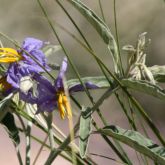Silver-leaf nightshade

Silver-leaf nightshade
© Bill Dodd Creative Commons

Silver-leaf nightshade
© Petrified Forest Creative Commons

Silver-leaf nightshade
© Petrified Forest Creative Commons
Native to North America, silver-leaf nightshade is a deep-rooted summer growing perennial plant from the Solanaceae family. It was first found in Australia in 1901 at Bingara, New South Wales and is now found throughout most parts of New South Wales, South East Queensland, Victoria, South Australia and Western Australia. Silver-leaf nightshade seriously reduces crop and pasture production and is listed as Weeds of National Significance.
You must manage the impacts of silver-leaf nightshade on your land.
You must not give away, sell or release silver-leaf nightshade into the environment.
Scientific name
Other names
- Silver-leaf nettle, silver-leaf bitter apple
Description
- Erect, multi-stemmed plant up to 60cm tall.
- Stems dieback over winter.
- Leaves are 5-10cm long, wavy edges, silvery-green with paler undersides.
- Spines are short brown, approximately 5mm long, occur on the stems and petioles.
- Flowers are up to 25mm in diameter, have 5 purple or white petals with 5 yellow stamens 5-7mm in length.
- Berries are green-striped, round, smooth, commonly 1cm in diameter which turn yellow-orange when ripe.
- Seeds are rounded, flattened, light-brown with irregular surface, 2.5-4mm wide.
- Roots create an interconnecting network with neighbouring plants to form a colony.
- Roots can penetrate to depths of 2m.
Habitat
- Can grow in most soil types.
Distribution
- Visit the Weeds Australia website and click on the distribution tab to access the distribution map.
Life cycle
- Usually flowers in November and can continue to March.
- Plants are dormant in winter when stems dieback will reshoot in spring.
- Berries are produced from December-March.
- Seedlings emerge at any time from late spring until autumn depending on rainfall.
- Will regrow from any root segment.
Impacts
Environmental
- Replaces native Solanum species.
Economic
- Reduces summer crop yields.
- Reduces annual pastures such as clover and rye.
- All parts of the plant are poisonous, especially the fruit.
- Costly to control.
How it is spread
- Spread from root fragments.
- Spread by seed carried by birds.
Prevention
Control
Silver-leaf nightshade colonies are not easily controlled as the extensive interconnecting root systems are difficult to totally control. It has a tremendous capacity to regenerate from root fragments. Colonies can re-establish even though they may have been controlled several seasons. Good farm hygiene is critical to prevent the spread of seed and root fragments.
Herbicide control
- To date there is no herbicide to eradicate a silver-leaf nightshade colony with a single application. Colonies need to be suppressed and run down with persistent control which includes annual herbicide applications to prevent berry set.
Biological control
- No known biological control agents.
Legal requirements
- Silver-leaf nightshade is a category 3 restricted invasive plant under the Biosecurity Act 2014.
- You must not give away, sell or release silver-leaf nightshade into the environment. Penalties may apply.
- You must take all reasonable and practical measures to minimise the biosecurity risks associated with dealing with silver-leaf nightshade under your control. This is called a general biosecurity obligation (GBO).
- At a local level, each local government must have a biosecurity plan that covers invasive plants in its area. This plan may include actions to be taken on silver-leaf nightshade. Some of these actions may be required under local laws. Contact your local government for more information.
Further information
- Contact the Customer Service Centre